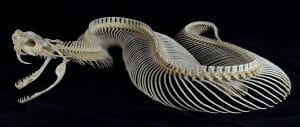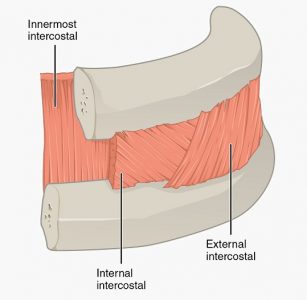Intercostal Muscles Definition
The intercostal muscles are a group of muscles found between the ribs which are responsible for helping form and maintain the cavity produced by the ribs. The muscles assist with expansion and contraction during breathing. The intercostal muscles consist of 11 muscle trios in humans.
Intercostal Muscles Overview
In humans, the muscles are solely for the purpose of expanding and contracting the rib cage. Other animals may have slightly different uses for the intercostal muscles, as discussed in the examples below. While the muscles serve generally the same purpose, they have been adapted in various ways in different organisms. These muscles are considered skeletal muscles.
There are 3 types of intercostal muscle. The innermost intercostal lies inside the ribs. The internal intercostal muscle sits between two ribs. The external intercostal muscles sit on the outside of the ribs. Between each of the 12 ribs, each of these three intercostal muscles is present. The first and last ribs only have intercostal muscles on one side.
The intercostal muscles relax while the lungs are expanding, allowing them to fill up with air. When an organism breathes out, the intercostal muscles contract to put pressure on the lungs and help drive the air out. This cycle continues constantly as an organism breathes.
Intercostal Muscles Function
Chest Cavity Expansion
In humans, the intercostal muscles play a large part in breathing. During inhalation, the diaphragm is relaxed, allowing the lungs to expand. The innermost intercostal muscles relax, while the external intercostal muscles contract, causing the chest cavity to expand. This expansion allows the lungs to fill with air, due to the negative pressure created by the extra space. Air fills the lungs, gases are exchanged, and it is time to exhale.
Chest Cavity Contraction
To force the air out, the chest cavity must become smaller, to put pressure on the air. To do this, the opposite process of inhalation happens. The diaphragm and external intercostal muscles contract, applying force to the bottom and sides of the lungs. The innermost intercostal muscles now contract, while the external intercostal muscles relax. This causes the chest cavity to contract as a whole, forcing the air out of your lungs. The internal intercostal muscles, or middle layer of muscle, helps keep the ribs from separating and holds the shape of the chest cavity.
Examples of Intercostal Muscles
Intercostal Muscles in Snakes
In different animals, intercostal muscles can perform different tasks. Snakes use their intercostal muscles in a different way than humans, based on their anatomy. Snakes typically only have one functioning lung, which fills along part of their body. Essentially, a snake has reduced its functional skeleton to a spine and rib cage. As in humans, the intercostal muscles in a snake play a role in bringing air into the lungs. By a similar process, the innermost and external intercostal muscles alternate their contracting and relaxing to expand and contract the lung.

Snakes, having no limbs, must also use their intercostal muscles when making a variety of other movements. While they have layers of muscles on top of their ribs that control their motion, the intercostal muscles have a much larger role to play in maintaining the shape and size of the body cavity.
For instance, when a constricting a prey item, a large snake creates an enormous amount of pressure with their muscles. This pressure is exerted not only on the prey item but also on the snake’s own body. To keep itself from damaging its internal organs, the snake must contract its intercostal muscles and create a strong cage around its lung, heart, and other sensitive organs.
Collapsible Rib Cages
Not surprisingly, snakes are not the only animals to have adapted their rib cage to be more flexible than humans. Many rodents have flexible rib cages. Having a flexible rib cage means you can get into tighter spaces. For a mouse or rat, this could mean the difference between survival and death. Whether escaping a predator or squeezing into a store of food, the ability to collapse the rib cage is important for many animals.
Not surprising, many animals that hunt rodents also have collapsible rib cages, to chase their prey into tight spaces. These animals include cats, ferrets, and badgers, to name a few. In all of these animals, the intercostal muscles must be more flexible and stretch further than in organisms like humans, which have a fixed rib cage.
Running Pains and Intercostal Muscles
Oftentimes, people will experience pain in their intercostal muscles when exercising heavily. This pain is often caused by lactic acid build-up in the intercostal muscles. The muscles must work at a feverish pace when breathing hard, constantly contracting and releasing as a person breathes harder. Any muscle, when receiving limited oxygen, cannot undergo respiration as a source of energy. Thus, they must resort to lactic acid fermentation.
As lactic acid fermentation proceeds to provide the muscles with energy, lactic acid builds up. The burning pain people feel in their ribs when exercising is the acid building up in their muscles. Luckily, lots of practice increases the amount of time a person can go before muscles switch to lactic acid fermentation. This is because regular exercise both increases the amount of oxygen carried by the blood, and the amount of oxygen which can be stored in the muscles.
Quiz

